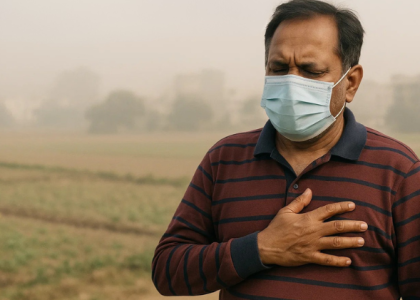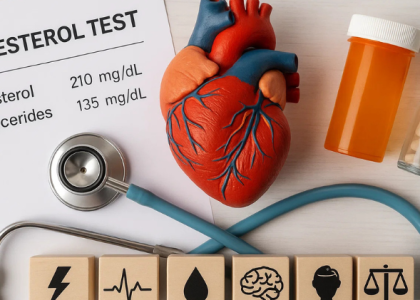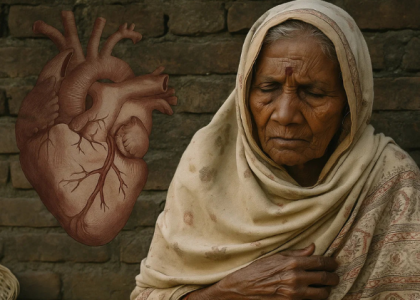Most people check the weather before going out — but not the air quality. Yet the invisible pollution you breathe each day may be silently damaging your heart, even if you feel fine right now. For South Asians living in cities from Delhi to Houston, this invisible threat deserves your attention.
A Heart Problem, Not Just a Lung Issue
When Ramesh suffered a heart attack at 52, his doctors were puzzled. He didn’t smoke, maintained a healthy weight, and had only slightly elevated cholesterol. But one factor stood out: he lived near a busy highway in Mumbai and took his morning walks along roadside paths. The air he breathed daily was putting extra stress on his heart.
The World Heart Federation reports some alarming statistics:
- Air pollution causes 7 million deaths per year worldwide
- 50% of those deaths are from heart disease and stroke — not lung problems
- Air pollution causes 25% of all heart disease deaths globally
- Air pollution causes 24% of all stroke deaths globally
- 9 out of 10 people breathe air that exceeds WHO safety limits
How Air Pollution Attacks Your Heart
We often think of air pollution as just a breathing problem, but its effects go much deeper:
- Tiny particles enter your bloodstream: When you breathe polluted air, microscopic particles pass through your lungs into your blood
- They damage your arteries: These particles irritate the inner lining of blood vessels, creating tiny injuries
- They trigger inflammation: Your body responds with inflammation, which can affect your entire circulatory system
- They make blood more likely to clot: Pollution exposure increases your risk of dangerous blood clots
- They raise blood pressure: Even short-term exposure can cause your blood pressure to spike
For people who already have risk factors like diabetes, high blood pressure, or a family history of heart problems, poor air quality can be the tipping point that triggers a heart attack or stroke.
Why South Asians Face Greater Risk
Several factors make outdoor air pollution especially dangerous for South Asians:
Biological Factors
- Higher rates of insulin resistance and diabetes
- Greater tendency to store harmful visceral (belly) fat
- More baseline inflammation in the body
- Genetic factors that affect how our bodies process toxins
Lifestyle and Environmental Exposure
- Dense urban populations with high traffic exposure
- Popular “morning walk culture” often in highly polluted hours
- Construction dust and industrial pollution in developing areas
- Cultural and religious outdoor gatherings in polluted settings
Anita, a 63-year-old grandmother in Delhi, noticed she often felt chest tightness after her morning walks. Her doctor suggested she change her walking time to after evening rain when air quality improved. Within weeks, her symptoms disappeared and her blood pressure readings stabilized.
Practical Ways to Protect Your Heart

While we can’t always control the air around us, these strategies can significantly reduce your exposure and risk:
Adjust Your Outdoor Activities
- Check air quality apps before going outside
- Walk in parks or green spaces away from traffic
- Exercise early morning or after rain when pollution is lower
- Consider indoor exercise on heavily polluted days
Create Cleaner Home Air
- Keep windows closed during peak pollution hours (usually morning and evening)
- Consider air purifiers, especially in bedrooms
- Use exhaust fans when cooking
- Keep indoor plants that help filter air
Travel Smarter
- Keep car windows closed in heavy traffic
- Consider wearing an N95 mask on very poor air quality days
- Take routes away from major highways when possible
- Support cleaner public transportation options
Medical Vigilance
- If you have existing heart conditions, monitor symptoms carefully on high pollution days
- Discuss air pollution exposure with your doctor as a heart risk factor
- Take prescribed heart medications consistently
- Stay well-hydrated to help your body process toxins
🩺 Ask Your Doctor If You Should Be Screened For…
- Coronary Calcium Score
- ApoB
- Lipoprotein(a)
- Fasting insulin
- High-sensitivity CRP (inflammation marker)
Extra Protection for High-Risk Days
On days when pollution levels are very high:
- Limit outdoor time to essential activities
- Postpone vigorous exercise until air quality improves
- Stay hydrated to help your body clear toxins
- Consider using air purifiers on their highest settings
- Watch for symptoms like unusual fatigue, chest discomfort, or shortness of breath
Taking Control of Your Air Environment
Just as you monitor your blood sugar or blood pressure, make air quality awareness part of your health routine. Free smartphone apps can provide daily air quality forecasts for your area, helping you make informed decisions.
Remember, even small adjustments matter. Moving your walk time by a few hours, choosing different routes, or investing in home air filtration can significantly reduce your exposure over time. These changes might seem minor, but they add up to meaningful protection for your heart.
You can’t single-handedly clean the air in your city, but you can take smart steps to reduce how much pollution reaches your heart. In doing so, you’re giving your cardiovascular system one less challenge to overcome — a gift your heart will thank you for in the years ahead.
Take action today: download an air quality app, consider your walking route, and talk with your doctor about how air pollution might be affecting your heart health. Your awareness is the first step toward protection.




